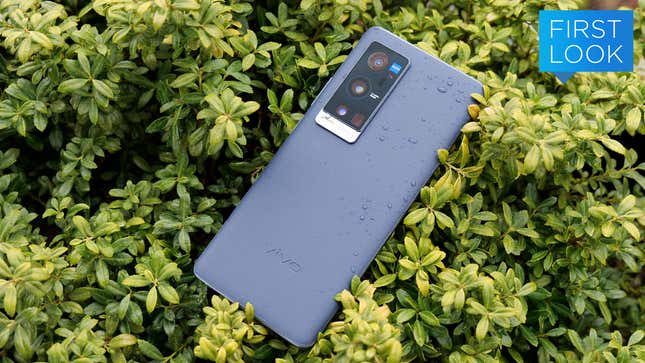
Just this week we saw OnePlus team up with legendary camera maker Hasselblad to seriously upgrade the photo quality of its latest devices, and now OnePlus’ sister company, Vivo, is doing something similar with Zeiss for its new X60 Pro+.
While I’ve only spent a short time checking out the X60 Pro+, I’ve been pleasantly surprised thus far. Even before you get to its camera, the X60 Pro+ impresses with a really slick design that’s all curvy tapered edges and a vegan leather back. It definitely adds a bit of luxury and drama to the package, though I admit I may be somewhat partial to this particular shade of blue.

The use of vegan leather is actually something we’ve seen before from Oppo (another phone maker that falls under the BBK Electronics umbrella), and it’s something I kind wish we would see more often on other phones, especially on handsets that are more widely available in the U.S.
The X60 Pro+ has a lot of other standard features you’d expect to find on a high-end phone, including an in-display fingerprint sensor, a gorgeous 6.5-inch FHD+ AMOLED screen with a 120Hz refresh rate (plus a 240Hz touch sample rate), a Snapdragon 888 processor, 12GB of RAM, and 256GB of storage.

Vivo is even leveraging the phone’s UFS 3.1 storage to help increase available memory through what the company calls Extended RAM, which uses up to 3GB of idle storage as memory to increase the number of apps you can have running in the background. It’s a neat trick for multitaskers who frequently leave a lot of apps open, though as someone who is rather aggressive about closing apps that I’m not using, it’s difficult to tell how much impact Vivo’s Extended RAM has on real world performance.
However, the real big upgrade on the X60 Pro+ is Vivo’s collaboration with Zeiss, which includes a number of contributions from the well known lens maker. To start, Vivo is using Zeiss’ special anti-reflective T* coating to help increase light transmission and cut down on reflections. Zeiss also helped Vivo hone its image processing and hardware testing, with Zeiss even lending Vivo the use of its Biotar Portrait mode, which creates a unique look using simulated bokeh.

The good stuff doesn’t stop there though. The X60 Pro+ also uses a 50-MP main sensor with pixel shift tech that allows people to shoot high-res 100-MP pics, while its 48-MP ultra-wide camera gets a dedicated gimbal system to help increase smoothness and stability. And for people who love phones with big zooms, the X60 Pro+ also gets a periscopic camera with a 5x optical zoom, which can be extended up to a 60x hybrid zoom.
Even in the camera app, I found myself routinely surprised at the number of built-in filters and AI-enhanced tuning options available across various modes and lenses. There’s a dedicated astrophotography mode designed to help you take better photos of starry skies, along with a pro sports mode (that can even activate automatically) to help you better capture fast-paced action.

Vivo even claims it chose to put the X60's front-facing cam in the middle of the screen instead off in a corner to help make it easier to properly compose and center your selfies.
Oddly, the one thing the X60 Pro+ doesn’t have is support for wireless charging, which seems like a weird omission on an otherwise feature-packed device. One last distinction: International X60 phones come with Vivo’s FunTouch OS, while Chinese variants get Vivo’s newer OriginOS Android skin.
The other bummer is that while Vivo is launching the X60 Pro+ internationally, there’s little info about potential U.S. availability or pricing. Currently, the X60 Pro+ is slated to cost 69,990 rupees in India, which is around $965. But as always, pricing can vary greatly between markets. And if you don’t fancy vegan leather, there’s also the standard X60 Pro, which features a more traditional glass back and a few slightly reduced specs, including a Snapdragon 870 chip and a shorter 2x telephoto zoom for 49,990 rupees (about $685).
But regardless of which one you choose, it’s interesting see different camera and lens makers pair up with smartphone vendors to help boost photo quality while also adding signature features that you won’t find on rivals.